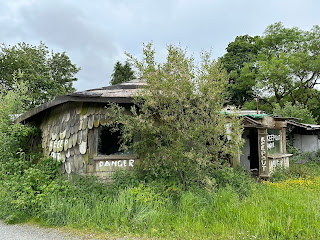On a sunny evening, I took a stroll around the outskirts of the village of Penpont. A rural and sleepy, little place in Dumfries and Galloway. Walking down a dirt track through the trees I could hear and see nothing of the modern world, and it made me think that the world must have looked much like this a couple of hundred years ago in the days of the fictional character Samuel Scrape. He was a man from Penpont who played a brief role in, what in my opinion is, one of the greatest Scottish novels ever written – The Private Memoirs and Confessions of a Justified Sinner by James Hogg. The book, published in 1824, is satire on the Calvinist doctrine of predestination: in which it is believed that God sits outside of time and therefore has already preordained who is saved and who is damned. The main character, Robert Wringhim is a staunch Calvinist who believes that he is one of those guaranteed Salvation. He falls under the influence of a mysterious figure called Gil-Martin who can transform his appearance at will. Gil-Martin leads Wringhim to believe that he is justified in killing those that he thinks are already damned by God, including his own brother. At one point Wringhim has locked himself away, with his only company being his manservant, Samuel Scrape, a peasant from ‘Penpunt’. However, Wringhim has no memory of having hired or paid Scrape and the suggestion is either that he was hired by Gil-Martin taking on the appearance of Wringhim, or that Wringhim is losing his mind. It all ends messily, and we are left wondering who Gil-Martin was, the devil, or maybe an aspect of Wringhim himself, a devilish figure of his own imagination.
I
kept an eye out for a Gil-Martin type character on my walk, but met no-one. Once, in the distance, I did spot a solitary
dog walker, though they vanished down another path before I could get close
enough to see if they had cloven hoofs and horns.
As
I walked, all was quiet around me, apart from the crunching of my feet on the
gravel path, the bubbling of the Scaur Water flowing nearby and the birds
singing up above. Following the path
around a tree lined corner I came across some derelict farm buildings that were
collapsing in on themselves. DANGER –
KEEP OUT was painted in dripping white paint numerous times on the sagging
walls, but being a curious type I had to go for a little nose around.
On
peering through broken windows, I could see that the buildings were pretty much
kaput. The roofs were caving in, and the
walls were tumbling down. Electrical
wiring hung down listlessly from broken beams and everything smelt of damp and
decay. Everything was in a creaking
collapse, just waiting for a strong wind to take it all down.
Walking
around the back of the buildings my ears were assaulted by a sudden frenzy of
squawking and cawing from what sounded like hundreds of rooks in the trees
above me. I then spotted several of their
young fledglings bopping around in a panic at my approach. Not quite having mastered the art of flight,
they jumped in a flapping wing fall around the high grass by the trees. As I got nearer the rooks above became louder
and louder while the young dashed for cover.
One of the young ones stuck his head into a gap between some logs, as if
like an ostrich, it was closing its eyes to approaching danger. I walked
quietly away and let it be.
I
have a vague memory of walking past these buildings several years back, and I
think they may have been workshops or something like that, but I could be
wrong. I don’t imagine for a minute
though that they’ll still be standing next time I pass by this way. Man, or nature will have taken then down by
then.
Before
leaving I placed a Skulferatu in a knothole in the wood of the owl like
building where it could keep an eye out on the young rooks dancing through the
grass and the undergrowth.
The
coordinates for the location of the Skulferatu are -
















